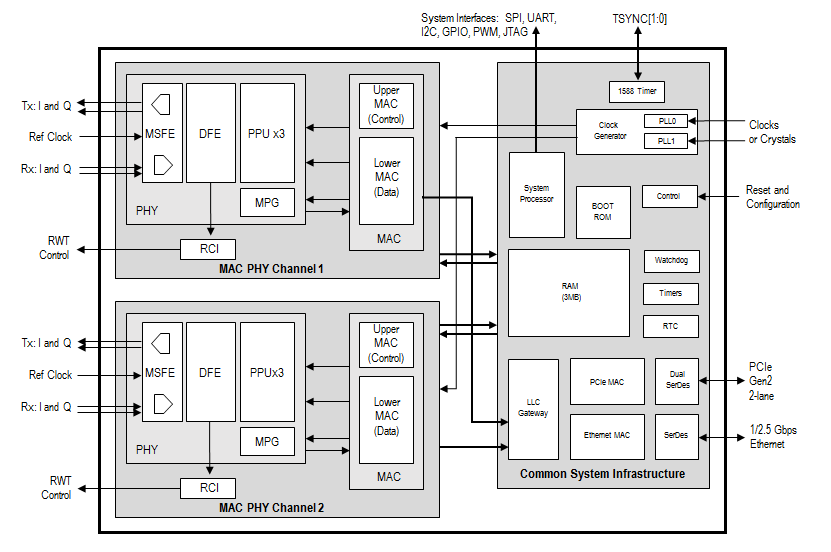Here’s a recap of interesting industry news from this past week:
Companies and Products
CEL (California Eastern Laboratories) introduced four low noise pHEMTs for Ku- and Ka-Band applications such as low noise block down-converters (LNB) in digital broadcast systems (DBS), down-converters in VSAT receivers and 24 GHz sensors. The devices are drop-in replacements for the equivalent Renesas pHEMTs and are priced lower than the Renesas parts.
GLOBALFOUNDRIES is expanding their capacity and capability worldwide, including fabs in New York, Germany, Singapore and China. New York will remain the center for extreme ultraviolet (EUV) lithography and 7 nm node development, with 7 nm production planned for Q2 2018.
At the International Solid-State Circuits Conference (ISSCC), IBM Research and Ericsson announced development of a 28 GHz, phased array module that integrates four SiGe MMICs and 64 dual-polarized antennas. The module measures approximately 2.8" x 2.8”. IBM and Ericsson claim this is the world’s first reported Si millimeter wave phased array antenna module operating at 28 GHz, which is a leading band for 5G.
IDT announced a baseband modem for multi-Gbps access and backhaul systems operating at millimeter wave. The RapidWave™ RWM6050 is a dual-channel modem that integrates the PHY, MAC, ADC and DAC functions, with additional beamforming capability for phased array antennas. The 28 nm CMOS IC will initially support links operating within 57 to 71 GHz, adding other bands in the future.

During IDT’s briefing to financial analysts last week, CTO Sailesh Chittipeddi said the company plans to expand their “smart silicon” RF products into additional markets, including automotive and test and measurement. Listen to his comments.

Infineon’s acquisition of Wolfspeed from Cree appears near death, as the Committee on Foreign Investment in the United States (CFIUS) judged the deal “poses a risk to the national security of the United States.” CFIUS has not identified any measures that “would adequately mitigate the particular national security risks.”
Intel plans to complete a mothballed, 7 nm, $7 billion wafer fab in Chandler, Arizona. As a sign of the new winds of political correctness, Intel’s CEO Brian Krzanich made the announcement at the White House, noting the fab will add 3,000 jobs.
LeddarTech and IDT are co-developing ICs for automotive LIDAR sensors that support the sub-$100 price target for LIDAR to be viable for mass adoption in self-driving vehicles.
Mercury Systems received a $4.1 million follow-on order for millimeter wave transceivers. They will be used in a high resolution imaging system for homeland security.
Qualcomm and the EPCOS segment of TDK formally launched their previously announced joint venture (JV). Named RF360, the JV combines Qualcomm’s system and semiconductor expertise with EPCOS’ filter capabilities to provide integrated front-end modules for mobile phones, competing with Broadcom, Murata, Qorvo and Skyworks. EPCOS owns 49 percent of the JV, Qualcomm 51 percent; Qualcomm has the option to buy out EPCOS after 30 months.
Mobile filter startup Resonant announced that one of their customers shipped more than 1 million pre-production SAW duplexers to four handset manufacturers. The three duplexers were designed with Resonant's proprietary design platform. These are Resonant’s first pre-production shipments, resulting from a licensing agreement signed in May 2016.
Skyworks promoted Steven Machuga to VP of worldwide operations. He replaces Bruce Freyman, who is retiring.
WIN Semiconductors reported Q4 and full-year financial performance. 2016 revenue grew 13 percent above 2015’s results, to NT$13,623 million ($439 million). Growth was fueled by mobile, Wi-Fi and infrastructure demand.
Markets and Technology
Cellular — Cisco updated their mobile Visual Networking Index (VNI), forecasting demand from 2016 to 2021. Virtually everyone in the wireless industry uses Cisco’s projections, so be sure to update your market forecast slides!

With new leadership, the FCC closed an investigation into “free data” policies offered by AT&T, T-Mobile and Verizon, saying they are popular with consumers. However, the FCC didn’t address the flip-side of the net neutrality question: when operators provide less favorable terms to their over-the-top (OTT) competitors.
5G — Ofcom, the communications regulator in the U.K., outlined plans for 5G spectrum. Ofcom plans auctions for 700 MHz and 3.4 to 3.6 GHz spectrum and is exploring the 3.6 to 3.8 and 26 GHz bands.
We hear a lot about 5G millimeter wave use for fixed wireless access (FWA). Verizon seems to be the leading proponent for this in the U.S. Yet FWA is no panacea, as consultant Doug Dawson discusses on his blog.
For those not working on wireless infrastructure or 5G, IEEE Spectrum wrote a tutorial with a well-produced video.
Autonomous Driving — California released road test data for self-driving cars for the year-long period from December 2015 to November 2016. Waymo compiled the best record by far, driving 636,000 miles with just 124 “disengagements” — where human intervention was needed — or 5,128 miles on average between disengagements.
Defense — A Standard Missile-3 (SM-3) fired from the USS John Paul Jones successfully intercepted a ballistic missile target off Hawaii in a joint U.S. Navy, Missile Defense Agency (MDA) test. Raytheon manufactures the SM-3, which is designed to defeat short- and intermediate-range ballistic missiles.
Thoughts? Leave a comment below.

